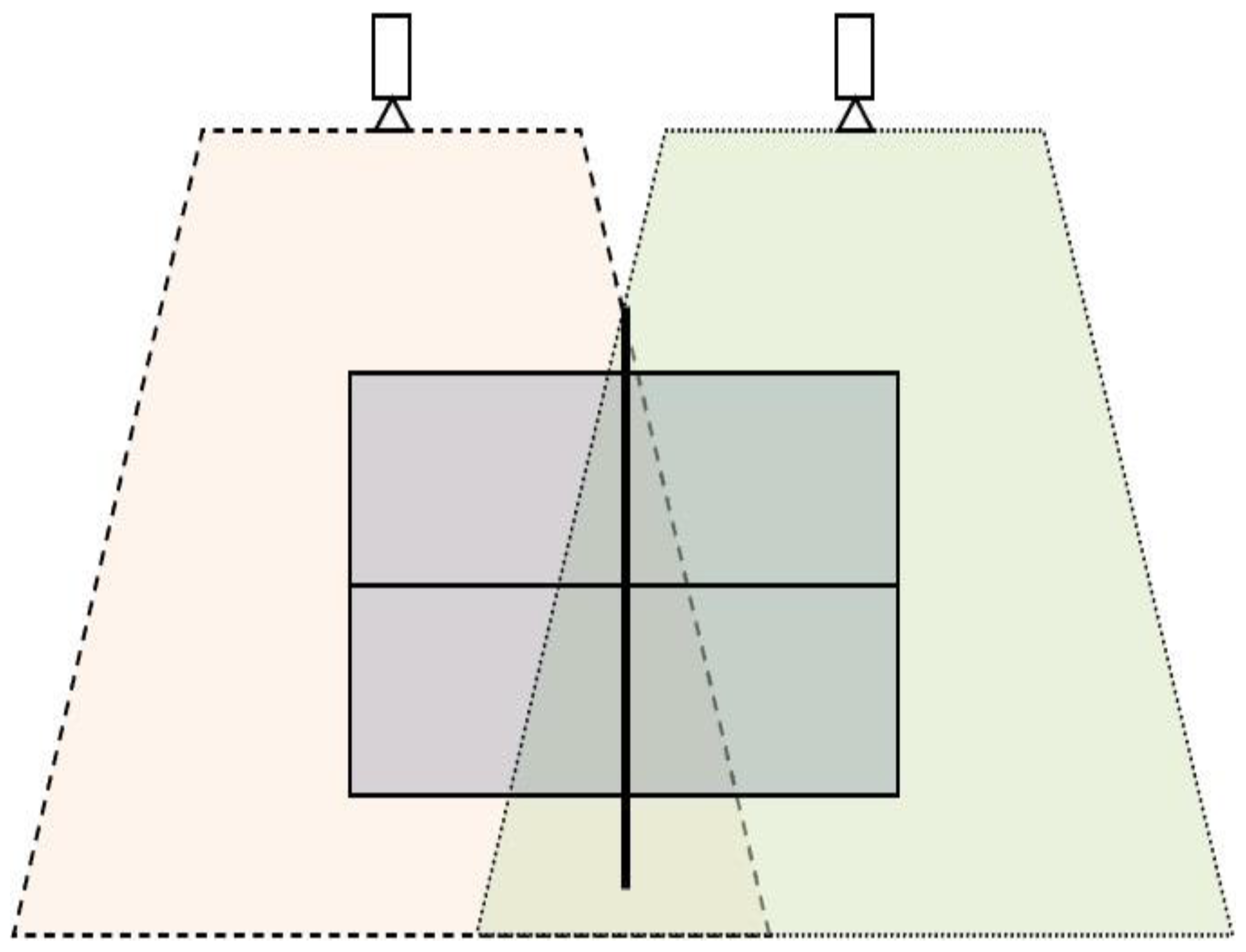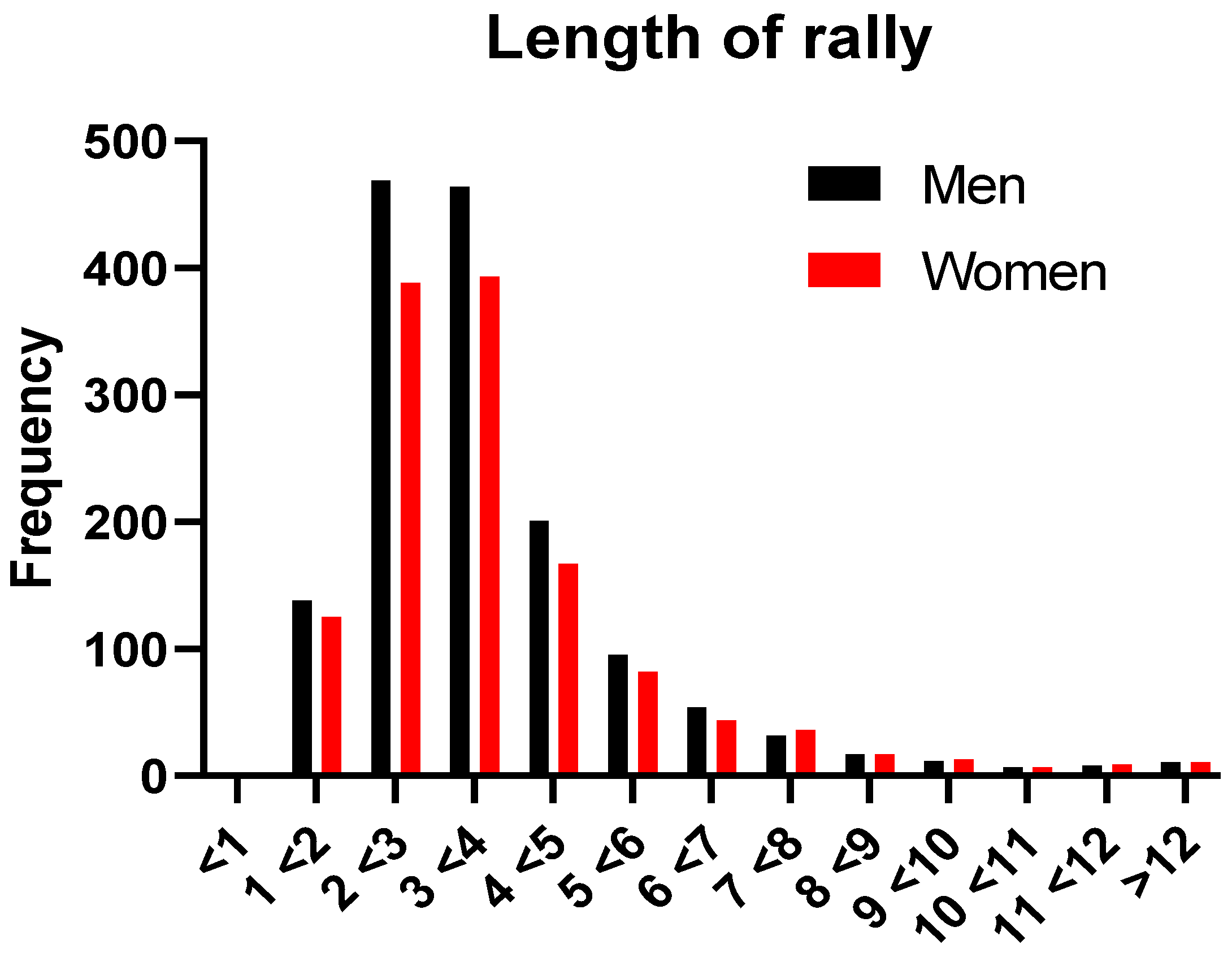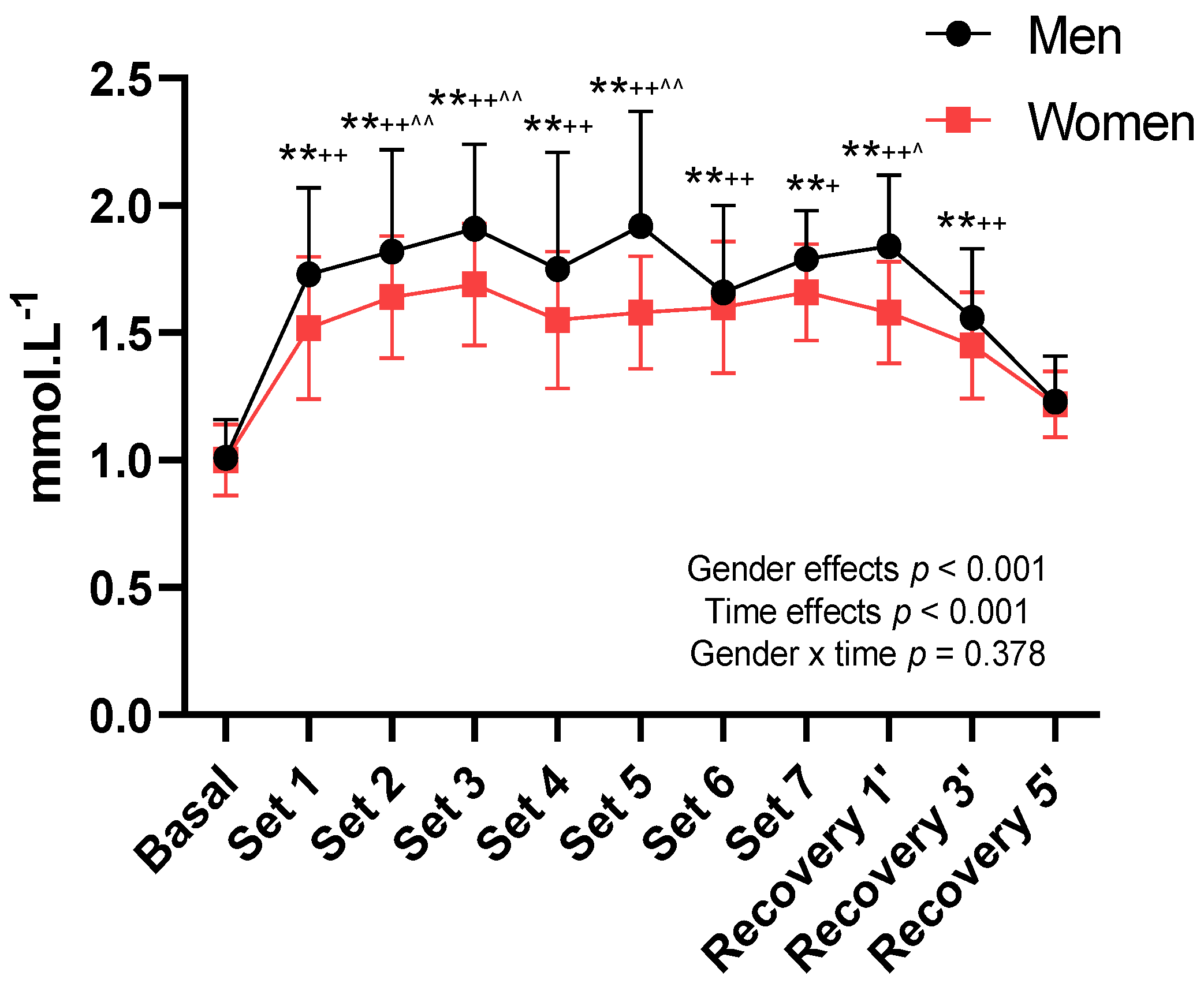Physiological Profile, Metabolic Response and Temporal Structure in Elite Individual Table Tennis: Differences According to Gender
Abstract
1. Introduction
2. Materials and Methods
2.1. Participants
2.2. Anthropometric Evaluation
2.3. Laboratory Measurements
2.4. Competition
2.5. Temporal Structure
2.6. Statistical Analysis
3. Results
4. Discussion
5. Conclusions
Author Contributions
Funding
Institutional Review Board Statement
Informed Consent Statement
Data Availability Statement
Acknowledgments
Conflicts of Interest
References
- Pradas, F.; Ara, I.; Toro, V.; Courel-Ibáñez, J. Benefits of Regular Table Tennis Practice in Body Composition and Physical Fitness Compared to Physically Active Children Aged 10–11 Years. Int. J. Environ. Res. Public Health 2021, 18, 2854. [Google Scholar] [CrossRef]
- Picabea, J.M.; Cámara, J.; Yanci, J. Physical Fitness Profiling of National Category Table Tennis Players: Implication for Health and Performance. Int. J. Environ. Res. Public Health 2021, 18, 9362. [Google Scholar] [CrossRef]
- de Mello Leite, J.V.; Barbieri, F.A.; Miyagi, W.; de Souza Malta, E.; Zagatto, A.M. Influence of game evolution and the phase of competition on temporal game structure in high-level table tennis tournaments. J. Hum. Kinet. 2017, 55, 55. [Google Scholar] [CrossRef] [PubMed]
- Kondrič, M.; Furjan-Mandić, G.; Kondrič, L.; Gabaglio, A. Physiological demands and testing in table tennis. Int. J. Table Tennis Sci. 2010, 6, 165–170. [Google Scholar]
- Pradas, F.; Martínez, P.; Rapún, M.; Bataller, V.; Castellar, C.; Carrasco, L. Assessment of table tennis temporary structure. Int. J. Table Tennis Sci. 2011, 7, 80–85. [Google Scholar]
- Michael, K.; Theofilos, P.; Aikaterini, V. Real play time in table tennis matches in the XXVIII Olympic Games Athens 2004. In Proceedings of the Book 10th Anniversary ITTF Sports Science Congress, Zagreb, Croatia, 18–20 May 2007; pp. 1–5. [Google Scholar]
- Pradas de la Fuente, F.; Salvá Martínez, P.; González Campos, G.; González Jurado, J.A. Analysis of performace indicators that define the modern table tennis. J. Sport Heal. Res. 2015, 7, 149–162. [Google Scholar]
- Zagatto, A.M.; Morel, E.A.; Gobatto, C.A. Physiological responses and characteristics of table tennis matches determined in official tournaments. J. Strength Cond. Res. 2010, 24, 942–949. [Google Scholar] [CrossRef]
- Zagatto, A.M.; Kondric, M.; Knechtle, B.; Nikolaidis, P.T.; Sperlich, B. Energetic demand and physical conditioning of table tennis players. A study review. J. Sports Sci. 2018, 36, 724–731. [Google Scholar] [CrossRef]
- Milioni, F.; Leite, J.V.d.M.; Beneke, R.; De Poli, R.A.B.; Papoti, M.; Zagatto, A.M. Table tennis playing styles require specific energy systems demands. PLoS ONE 2018, 13, e0199985. [Google Scholar] [CrossRef]
- Kondrič, M.; Zagatto, A.M.; Sekulić, D. The physiological demands of table tennis: A review. J. Sports Sci. Med. 2013, 12, 362. [Google Scholar]
- Zagatto, A.M.; de Mello Leite, J.V.; Papoti, M.; Beneke, R. Energetics of Table Tennis and Table Tennis–Specific Exercise Testing. Int. J. Sports Physiol. Perform. 2016, 11, 1012–1017. [Google Scholar] [CrossRef]
- Yuza, N.; Sasaoka, K.; Nishioka, N.; Matsui, Y.; Yamanaka, N.; Ogimura, I.; Takashima, N.; Miyashita, M. Game analysis of table tennis in top Japanese players of different playing styles. Int. J. Table Tennis Sci. 1992, 1, 79–89. [Google Scholar]
- Sperlich, B.; Koehler, K.; Holmberg, H.-C.; Zinner, C.; Mester, J. Table tennis: Cardiorespiratory and metabolic analysis of match and exercise in elite junior national players. Int. J. Sports Physiol. Perform. 2011, 6, 234–242. [Google Scholar] [CrossRef][Green Version]
- Castellar, C.; Pradas, F.; Carrasco, L.; De La Torre, A.; González-Jurado, J.A. Analysis of reaction time and lateral displacements in national level table tennis players: Are they predictive of sport performance? Int. J. Perform. Anal. Sport 2019, 19, 467–477. [Google Scholar] [CrossRef]
- Feliu, J.; Ventura, J.L.; Segura, R.; Rodas, G.; Riera, J.; Estruch, A.; Zamora, A.; Capdevila, L. Differences between lactate concentration of samples from ear lobe and the finger tip. J. Physiol Biochem. 1999, 55, 333–339. [Google Scholar]
- Pradas, F.; Floría, P.; González-Jurado, J.A.; Carrasco, L.; Bataller, V. Development of an observational tood for table tennis analysis. J. Sport Heal. Res. 2012, 4, 255–268. [Google Scholar]
- Altman, D.G. Practical Statistics for Medical Research Chapman and Hall; CRC Press: London, UK, 1991. [Google Scholar]
- Kasai, J.; Ohta, A.; Jung, T.E.; Mori, T. Research on table tennis players cardio-respiratory endurance. Int. J. Table Tennis Sci. 2010, 6, 1–3. [Google Scholar]
- Katsikadelis, M.; Pilianidis, T.; Misichroni, A. Comparison of Rally Time in XXIX Beijing (2008) and XXVIII Athens (2004) Olympic Table Tennis Tournaments. Int. J. Table Tennis Sci. 2010, 6, 55–59. [Google Scholar]
- Pradas, F.; Pinilla, J.M.; Quintas, A.; Castellar, C. Game characteristics and time structure in high level table tennis. Rev. Int. Deport. Colect. 2014, 19, 5–16. [Google Scholar]
- Fernandez-Fernandez, J.; Jose, G.; Moya-Ramon, M.; Cabello-Manrique, D.; Mendez-Villanueva, A. Gender differences in game responses during badminton match play. J. Strength Cond. Res. 2013, 27, 2396–2404. [Google Scholar] [CrossRef]
- O’Donoghue, P.; Ingram, B. A notational analysis of elite tennis strategy. J. Sports Sci. 2001, 19, 107–115. [Google Scholar] [CrossRef]
- Torres-Luque, G.; Ramirez, A.; Cabello-Manrique, D.; Nikolaidis, T.P.; Alvero-Cruz, J.R. Match analysis of elite players during paddle tennis competition. Int. J. Perform. Anal. Sport 2015, 15, 1135–1144. [Google Scholar] [CrossRef]
- Smekal, G.; von Duvillard, S.P.; Rihacek, C.; Pokan, R.; Hofmann, P.; Baron, R.; Tschan, H.; Bachl, N. A physiological profile of tennis match play. Med. Sci. Sports Exerc. 2001, 33, 999–1005. [Google Scholar] [CrossRef] [PubMed]
- Cabello, D.; Padial, P.; Lees, A.; Rivas, F. Temporal and Physiological Characteristics of Elite Women’s and Men’s Singles Badminton. Int. J. Appl. Sport. Sci. 2004, 16, 1–12. [Google Scholar]
- Chen, H.L.; Wu, C.J. Physiological and Notational Comparison of New and Old Scoring Systems of Singles Matches in Men’s Badminton. Asian J. Phys. Educ. Recreat. 2011, 17, 6–17. [Google Scholar] [CrossRef]
- Zagatto, A.M.; Papoti, M.; Gobatto, C.A. Validity of critical frequency test for measuring table tennis aerobic endurance through specific protocol. J. Sports Sci. Med. 2008, 7, 461. [Google Scholar] [PubMed]
- Allen, G.D. Physiological-characteristics of elite Australian table-tennis athletes and their responses to high-level competition. J. Hum. Mov. Stud. 1991, 20, 133–147. [Google Scholar]
- Suchomel, A. A comparison of exercise intensity on different player levels in table tennis. Int. J. Table Tennis Sci. 2010, 6, 79–82. [Google Scholar]
- Baron, R.; Petschnig, R.; Bachl, N.; Raberger, G.; Smekal, G.; Kastner, P. Catecholamine excretion and heart rate as factors of psychophysical stress in table tennis. Int. J. Sports Med. 1992, 13, 501–505. [Google Scholar] [CrossRef]
- Djokic, Z. Heart rate monitoring of table tennis players. In Proceedings of the Science and Racket Sports III: The Proceedings of the Eighth International Table Tennis Federation Sports Science Congress and The Third World Congress of Science and Racket Sports, Paris, France, 17–19 May 2003; Routledge: London, UK, 2004; p. 24. [Google Scholar]
- Barchukova, G.V.; Salakova, E.V. Ergometric characteristics of table tennis. Sov. Sport. Rev. Dec 1991, 4, 164. [Google Scholar]
- Hoshino, S. Psychophysiological evaluation of cardiovascular response on the observational and practical task dificulty. Br. J. Sports Med. 2013, 47, e4. [Google Scholar] [CrossRef]
- Iimoto, Y.; Yoshida, K.; Yuza, N. Rebound characteristics of the new table tennis Ball; Differences between the 40 mm (2.7 g) and 38 mm (2.5 g) balls. Int. J. Table Tennis Sci. 2002, 5, 233–243. [Google Scholar]
- Tang, H.; Mizoguchi, M.; Toyoshima, S. Speed and spin characteristics of the 40 mm table tennis ball. Int. J. Table Tennis Sci. 2002, 5, 278–284. [Google Scholar]
- Zhang, H.; Hohmann, A. Table tennis after the introduction of the 40 mm ball and the 11 point format. In Science and Racket Sports III; Lees, A., Kahn, J.-F., Maynard, I.W., Eds.; Routledge: London, UK, 2004; pp. 227–232. [Google Scholar]
- Jensen-Urstad, M.; Svedenhag, J.; Sahlin, K. Effect of muscle mass on lactate formation during exercise in humans. Eur. J. Appl. Physiol. Occup. Physiol. 1994, 69, 189–195. [Google Scholar] [CrossRef]
- Hafen, P.S.; Vehrs, P.R. Sex-related differences in the maximal lactate steady state. Sports 2018, 6, 154. [Google Scholar] [CrossRef]
- Korhonen, M.T.; Suominen, H.; Mero, A. Age and sex differences in blood lactate response to sprint running in elite master athletes. Can. J. Appl. Physiol. 2005, 30, 647–665. [Google Scholar] [CrossRef]
- Martin, C.; Favier-Ambrosini, B.; Mousset, K.; Brault, S.; Zouhal, H.; Prioux, J. Influence of playing style on the physiological responses of offensive players in table tennis. J. Sports Med. Phys. Fitness 2015, 55, 1517–1523. [Google Scholar]



| Variable | Men | Women | p | ||
|---|---|---|---|---|---|
| M ± SD | Range | M ± SD | Range | ||
| Age (y) | 25.3 ± 4.07 | 19–38 | 22.3 ± 3.8 | 18–31 | 0.007 |
| Height (m) | 1.75 ± 0.06 | 1.62–1.68 | 1.65 ± 0.06 | 1.52–1.75 | <0.001 |
| Weight (kg) | 69.9 ± 9.2 | 50.8–89.6 | 57.6 ± 6.2 | 48.3–69.8 | <0.001 |
| BMI (kg·m−2) | 22.6 ± 2.3 | 18.8–27.2 | 20.9 ± 1.6 | 18.3–24.4 | 0.006 |
| HRmax (beats·min−1) | 194.6 ± 6.3 | 176–207 | 195.5 ± 4.6 | 184–200 | 0.574 |
| VO2max (ml·kg·min−1) | 53 ± 6.03 | 41–63 | 44.2 ± 5.6 | 32–54 | <0.001 |
| Vmax (km·h−1) | 17.8 ± 1.4 | 14–20 | 13.8 ± 0.5 | 13–15 | <0.001 |
| LAmax (mmol·L−1) | 13 ± 2.2 | 9.7–18.6 | 11.1 ± 2.0 | 9–15 | <0.001 |
| Experience (y) | 16.04 ± 4.1 | 10–30 | 13.2 ± 3.8 | 10–22 | 0.011 |
| Table tennis training volume (h/week) | 17.38 ± 2.92 | 12–22 | 17.92 ± 2.69 | 14–22 | 0.894 |
| Complementary training (h/week) | 2.79 ± 1.32 | 1–5 | 2.83 ± 1.34 | 1–5 | 0.975 |
| Variable | Men | Women | |||
|---|---|---|---|---|---|
| Match | |||||
| M ± SD | Range | M ± SD | Range | p | |
| TT (s) | 2256.05 ± 979.7 | 993.6–3507.7 | 1469.4 ± 544.2 | 783.1–2379.1 | 0.024 |
| RPT (s) | 395.06 ± 149.3 | 217.6–651.2 | 360.4 ± 131.4 | 194.08–693.6 | 0.553 |
| TRT (s) | 1860.9 ± 838.2 | 775.9–2896.4 | 1104.4 ± 459.1 | 589.1–1954.8 | 0.012 |
| GD (s) | 0.27 ± 0.05 | 0.20–0.38 | 0.41 ± 0.13 | 0.25–0.57 | 0.006 |
| Rally | |||||
| RPT (s) | 3.6 ± 0.3 | 3.01–4.2 | 4.3 ± 1.07 | 3.08–6.4 | 0.035 |
| TRT (s) | 13.6 ± 2.7 | 9.1–19.3 | 11.2 ± 2.7 | 6.9–16.5 | 0.042 |
| Variable | Men | Women | |||
|---|---|---|---|---|---|
| M ± SD | Range | M ± SD | Range | p | |
| HRmax (beats·min−1) | 163.9 ± 8.7 | 147–177 | 155.4 ± 8.01 | 139–167 | <0.001 |
| HRmin (beats·min−1) | 111.3 ± 12.7 | 92–138 | 104.5 ± 7.5 | 93–118 | 0.029 |
| HRmean (beats·min−1) | 138.7 ± 12.08 | 114–159 | 137.2 ± 6.03 | 127–148 | 0.572 |
| HRmean (%HRmax) | 71.43 ± 7.08 | 57.29–82.39 | 70.25 ± 4.15 | 65.15–80.43 | 0.485 |
| LAbasal (mmol·L−1) | 1.01 ± 0.15 | 0.75–1.30 | 1.00 ± 1.14 | 0.73–1.24 | 0.780 |
| LAmax (mmol·L−1) | 1.8 ± 0.2 | 1.4–2.5 | 1.5 ± 0.2 | 1.1–1.9 | <0.001 |
Publisher’s Note: MDPI stays neutral with regard to jurisdictional claims in published maps and institutional affiliations. |
© 2021 by the authors. Licensee MDPI, Basel, Switzerland. This article is an open access article distributed under the terms and conditions of the Creative Commons Attribution (CC BY) license (https://creativecommons.org/licenses/by/4.0/).
Share and Cite
Pradas, F.; de la Torre, A.; Castellar, C.; Toro-Román, V. Physiological Profile, Metabolic Response and Temporal Structure in Elite Individual Table Tennis: Differences According to Gender. Int. J. Environ. Res. Public Health 2021, 18, 11898. https://doi.org/10.3390/ijerph182211898
Pradas F, de la Torre A, Castellar C, Toro-Román V. Physiological Profile, Metabolic Response and Temporal Structure in Elite Individual Table Tennis: Differences According to Gender. International Journal of Environmental Research and Public Health. 2021; 18(22):11898. https://doi.org/10.3390/ijerph182211898
Chicago/Turabian StylePradas, Francisco, Ana de la Torre, Carlos Castellar, and Víctor Toro-Román. 2021. "Physiological Profile, Metabolic Response and Temporal Structure in Elite Individual Table Tennis: Differences According to Gender" International Journal of Environmental Research and Public Health 18, no. 22: 11898. https://doi.org/10.3390/ijerph182211898
APA StylePradas, F., de la Torre, A., Castellar, C., & Toro-Román, V. (2021). Physiological Profile, Metabolic Response and Temporal Structure in Elite Individual Table Tennis: Differences According to Gender. International Journal of Environmental Research and Public Health, 18(22), 11898. https://doi.org/10.3390/ijerph182211898









